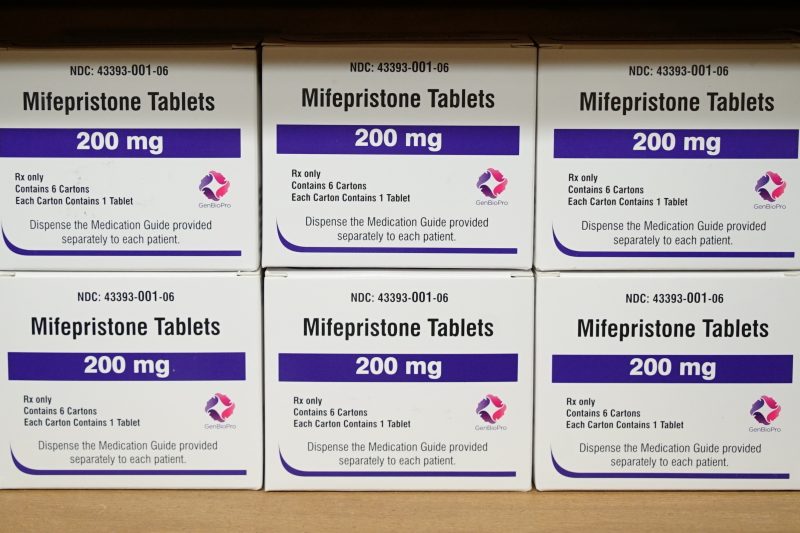The plane from London had landed at New York’s John F. Kennedy International Airport, and Leona Benten was weeping on the tarmac when U.S. customs officials seized the abortion pills she wanted to use to end her pregnancy, which were banned in America.
Benten, a social worker and activist from Berkeley, Calif., was 6½ weeks pregnant and 29 years old when she volunteered in the summer of 1992 to be the test case in the legal fight challenging the Food and Drug Administration’s ban on importing RU-486, the French-made abortion pill that later became known as mifepristone. Lawrence Lader, an influential abortion rights leader who organized the trip for Benten, had notified U.S. customs officials in advance of what was happening. Then, federal officials confronted her and confiscated her pills on July 1, 1992.
“I don’t like surgery, I don’t like hospitals, and I believe in self-determination,” Benten told the New York Times in 1992, “so I’d much rather take a pill than put myself in the hands of someone who’s going to do a procedure on me.”
After she wiped away the tears shed on that runway, Benten — a liberal activist the Times characterized as “the very model of a politically active feminist” — was hellbent on making a statement in a class-action lawsuit. Eventually, she would take her case all the way to the Supreme Court.
Although Benten lost her Supreme Court case to regain her pills in a 7-2 decision and chose to get a surgical abortion, she had pushed mifepristone into the national spotlight and helped galvanize a movement to overturn the American ban on the drug. The FDA approved mifepristone in 2000 in what the president of Planned Parenthood said was “the most significant technological advance in women’s reproductive health care since the birth control pill.”
“I didn’t believe this story would get so big,” Lader told the Los Angeles Times in 1992.
Benten’s case resonates more than three decades later, after mifepristone’s legal status was cast into uncertainty Friday night when rulings from two federal judges reached contradictory conclusions on a medication used in more than half of abortions in the United States.
In Texas, U.S. District Judge Matthew J. Kacsmaryk, a nominee of President Donald Trump with long-held antiabortion views, agreed with the conservative groups in a lawsuit seeking to reverse the FDA’s approval of mifepristone as safe and effective, including in states where abortion rights are protected. The ruling, which was denounced by President Biden, was the first time a judge suspended longtime FDA approval of a medication despite opposition from the agency and the drug’s manufacturer.
In Washington state, U.S. District Judge Thomas O. Rice, who was nominated by President Barack Obama, issued a competing opinion late Friday saying the drug was safe and effective. The Washington judge ordered the FDA to preserve “the status quo” and retain access in the 17 states, as well as D.C., that are behind a lawsuit seeking to protect medication abortion.
Medication-induced abortions using drugs such as mifepristone have become an increasingly contentious issue since the Supreme Court overturned Roe v. Wade in June, ending the nation’s constitutional right to abortion. But the fight to bring the drug to America began after the FDA banned the import of RU-486 in June 1989, due, in part, to pressure from conservative lawmakers.
It’s unclear whether Benten knew what would unfold when she called the Women’s Choice Clinic in Oakland, Calif., about getting an abortion in 1992. Benten did not immediately respond to an interview request Saturday morning. She has given few interviews and appears to not have spoken on the topic publicly in decades.
In the early 1990s, lawyers and abortion rights groups were looking for their next Jane Roe in the fight to legalize RU-486. She needed to be under 35, a nonsmoker, in the first weeks of pregnancy and “willing to put herself on the line and interested in pushing the FDA’s back against the wall,” Linci Comy of the Oakland clinic told the Los Angeles Times in 1992.
Benten, who had been active in causes such as abortion rights, lesbian rights and prisoners’ rights for years, quickly agreed to be the face of the case.
Benten said she was uneasy about the publicity that would follow, especially because she had decided to use her real name in the legal proceedings.
“I had no idea about how much attention this was going to get, so we never really talked about using a pseudonym or keeping my identity confidential,” she said, according to the New York Times. “It’s uncomfortable to have my face all over the place, and to have everybody knowing what’s going on with me when I walk down the street.”
She also faced scrutiny for not divulging much background or biographical information about herself, telling the Los Angeles Times in a rare interview in July 1992 that people “don’t need to know anything about me.”
Lader championed his client but said the attention had made her “exhausted,” “furious” and “a little difficult.”
“Leona Benten was supposed to engender sympathy in her role as the banner-carrier for RU-486,” the Los Angeles Times wrote in large type. “But she proved to have a mind, and an agenda, of her own.”
The legal back-and-forth ramped up weeks after the airport confrontation. After Benten’s lawyers argued that banning mifepristone was due to the political motivations of President George H.W. Bush’s administration, U.S. District Judge Charles Sifton of Brooklyn, an appointee of President Jimmy Carter, ruled in Benten’s favor and ordered her pills be returned to her. When the 2nd U.S. Circuit Court of Appeals in New York temporarily blocked the order, Benten’s attorneys took the case to the Supreme Court as an emergency legal request on July 15, 1992.
Supreme Court Justice Clarence Thomas, who reviewed decisions in the district where Benten’s suit was filed, obtained a full opinion from the court on July 17, 1992, concluding that the woman’s attorneys failed to adequately make their case that the confiscation of the abortion pills was illegal. The ruling was a 7-2 decision, with Justices John Paul Stevens and Harry A. Blackmun, who wrote the 1973 decision for Roe, dissenting.
After the high court’s ruling, Benten told the Associated Press she was disappointed that she would now have to go through with a surgical abortion. She was eight weeks pregnant at the time.
Though her case was defeated, it got the attention of Rep. Ron Wyden (D-Ore.), who introduced a bill in July 1992 to overturn the ban on RU-486.
Medical authorities testified that the ban of the drug was based more on the Bush administration’s antiabortion views than on scientific judgments. The bill did not pass, but it helped lay the groundwork for future action once President Bill Clinton arrived at the White House in 1993.
Clinton pushed for his administration to investigate mifepristone’s use for medication abortion, and clinical testing began in the United States. The process culminated in September 2000, when the FDA approved the drug more than a decade after it was brought to market in France.
When she was going through the legal back-and-forth, Benten, who was at times too choked up to speak in court during the lawsuit, acknowledged to the New York Times that while she wasn’t sure that she’d be able to take the abortion pill, she was hopeful it would make a difference for others in a similar position.
“I’m not very hopeful right now that I’ll be able to get the pills on time,” she said. “But sooner or later, RU-486 will be available to American women.”
Ann E. Marimow, Caroline Kitchener, Perry Stein, Robert Barnes and Derek Hawkins contributed to this report.








